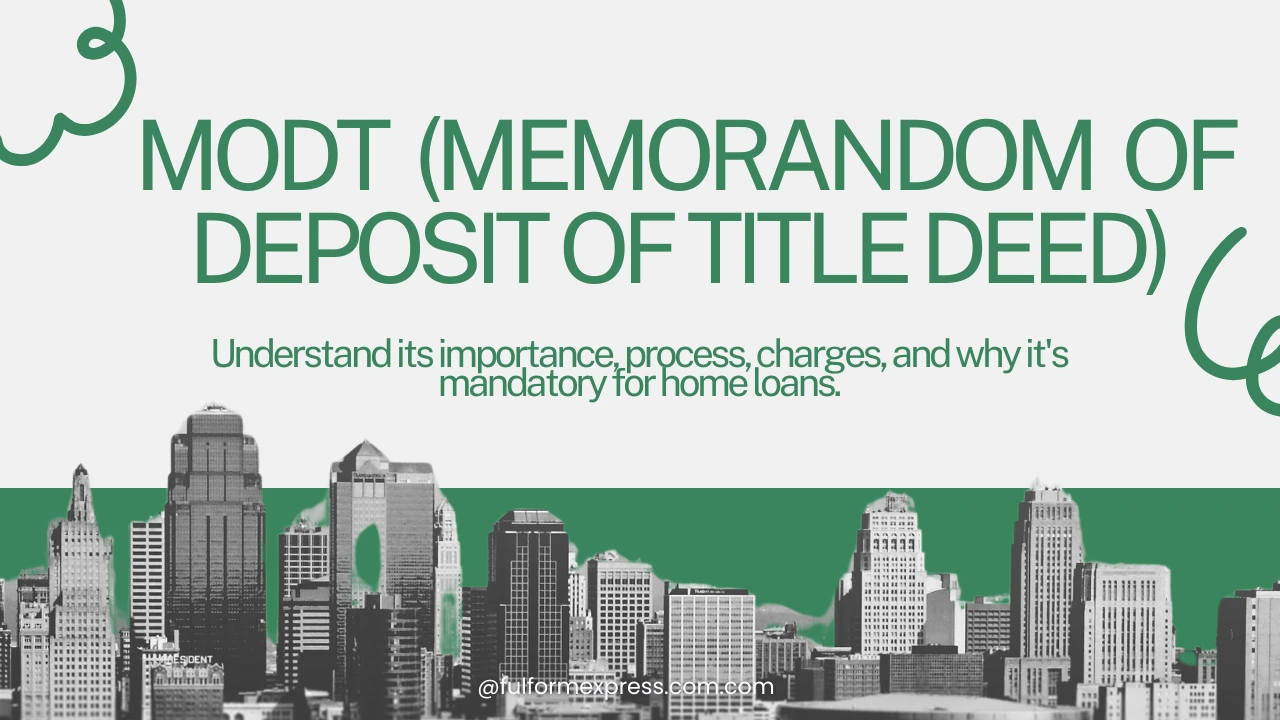The MODT full form is essential to know while applying for a home loan. The Memorandum of Deposit of Title Deeds, MODT, is the legal agreement between the borrower and the lender. It also protects the lender by retaining the original title documents. It also protects the borrower’s rights.
When you borrow a home loan, the bank retains your property documents as security. The MODT is the evidence that the documents are lodged with the bank. This document also clearly defines the rights and responsibilities for both parties. It is now,” under the new RERA regulations, ”mandatory. Here in this guide, we will explain everything you need to know about MODT full form, charges and what happens.
What Is MODT Full Form?
The MODT full form stands for Memorandum of Deposit of Title Deeds. It is a legal agreement where the borrower deposits original property documents with the bank. This serves as security for the home loan. The MODT document clearly defines the lender’s rights over the property until the loan is repaid.
Previously, MODT was optional. But under new RERA rules, it is now compulsory for all registered home loans. Banks must execute the MODT agreement on stamp paper. This agreement proves that the bank holds original title deeds until the loan is cleared.
Importance of MODT in Home Loans
The MODT full form is essential in understanding how home loans work. It legally protects both the lender and the borrower. For the bank, it serves as security. For the borrower, it acts as a safeguard against wrongful claims or disputes. Without a valid MODT, it becomes difficult for banks to establish legal control over the property.
This document ensures that the borrower’s property is safely held until the loan is cleared. It also helps in easy retrieval of documents once the loan is paid off.
MODT Full Form Charges Explained
When you sign the MODT agreement, there are charges involved. These charges include stamp duty and processing fees. They usually range between 0.1% to 0.3% of the loan amount. These charges are paid by the borrower when executing the agreement.
| Loan Amount | MODT Charges (Approx.) |
| ₹10 lakhs | ₹3,000 |
| ₹30 lakhs | ₹9,000 |
| ₹50 lakhs | ₹15,000 |
The stamp duty payable cannot exceed ₹25,000. Administrative fees, custody charges, and insurance costs may also be applied. Discuss these charges with your bank to possibly lower them.
Why Borrowers Need To Pay MODT Charges?
Borrowers often wonder why they must pay MODT charges. After all, the document protects the bank’s interest. However, the MODT also benefits the borrower. It legally outlines the process for returning title deeds upon loan repayment. It also ensures fair dealings between both parties.
Process of MODT Full Form
The MODT involves several steps. Here’s a simple breakdown:
- The borrower deposits original property documents with the bank.
- An MODT agreement is signed between the bank and borrower.
- The agreement states the lender’s rights until the loan is repaid.
- Upon full payment, the documents are returned, and the MODT is cancelled.
How MODT Protects The Lender’s Interests?
The MODT is crucial for the lender. Banks offer huge loan amounts, and the MODT provides security. If a borrower defaults, the bank can take legal action. This may include repossession or auction of the property.
The agreement also ensures the bank’s right to ask for additional collateral if the property’s value decreases. This protects the bank’s investment from unforeseen losses.
How MODT Protects The Borrower’s Interests?
Borrowers benefit from the MODT as it legally defines their rights. It details the conditions under which the bank can repossess the property. The borrower can also demand the return of documents once the loan is repaid.
The MODT ensures the bank cannot unfairly withhold documents. If the bank delays, the borrower can use the agreement to demand a timely return.
MODT Cancellation Process
When the loan is fully repaid, the MODT process requires cancellation. This is essential for reclaiming property rights.
Steps to cancel MODT:
- Clear the entire loan amount.
- Obtain a No Objection Certificate (NOC) from the bank.
- Apply for MODT cancellation with the registrar.
| Steps | Description |
| Loan Repayment | Pay off the full loan amount. |
| NOC Collection | Obtain NOC from the bank. |
| Registrar Process | Apply for cancellation. |
Is MODT Mandatory For All Home Loans?
Yes, executing the MODT full form is compulsory for all registered home loans. Earlier, it was optional. But recent regulations require banks to execute it on stamp paper. This change helps safeguard both lenders and borrowers.
Conclusion
The MODT full form, or Memorandum of Deposit of Title Deeds, is essential for home loans. It safeguards both parties by clearly outlining rights and obligations. The charges are minimal compared to the security it offers. Always ensure that the MODT agreement is correctly executed and cancelled after repaying the loan. It helps maintain clear property ownership and prevents disputes. Understanding the MODT full form will help you manage your home loan effectively.
Frequently Asked Questions (FAQs)
Q1. What is the MODT full form?
Ans. MODT full form is Memorandum of Deposit of Title Deeds. It is a legal agreement where the borrower deposits property documents with the bank as security.
Q2. Is MODT mandatory for all home loans?
Ans. Yes, MODT is mandatory for all registered home loans under the new RERA rules.
Q3. How much are MODT charges?
Ans. MODT charges usually range between 0.1% to 0.3% of the loan amount, but cannot exceed ₹25,000.
Q4. Can borrowers negotiate MODT charges?
Ans. Yes, borrowers can negotiate administrative charges with the bank to possibly reduce costs.
Q5. What happens after loan repayment?
Ans. After repayment, the bank returns the original documents, issues a NOC, and the MODT is cancelled.
Read More Blogs:-)










